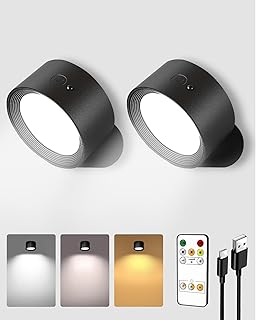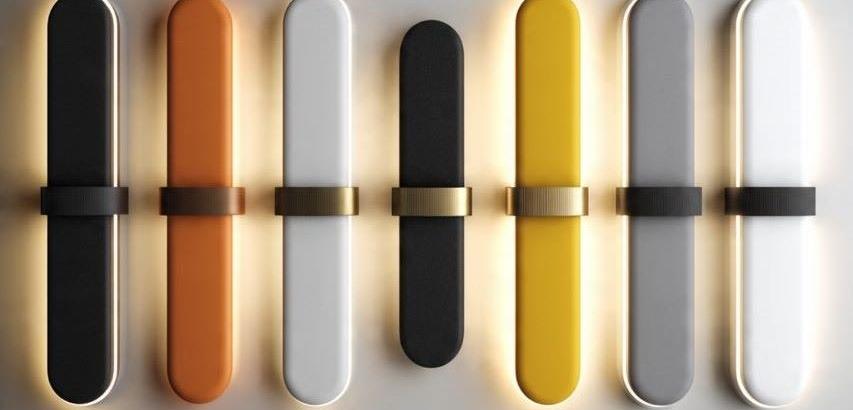Magnetic LED Wall Lights are a modern and innovative category of lighting that combines the energy efficiency and longevity of Light Emitting Diodes (LEDs) with the flexibility and convenience of a magnetic attachment system. They represent a significant departure from traditional, permanently fixed lighting, offering a new level of modularity and user control in interior design.
Core Concept and How They Work
The fundamental principle is simple yet powerful:
A Fixed Mounting Plate: A low-profile, electrically active metal track or plate is securely and permanently mounted to the wall. This plate is connected to your home's electrical system, either via hardwiring into a wall junction box (replacing a traditional light switch) or, in some plug-in models, via a discreet cable.
A Detachable Light Unit: The light fixture itself (the sconce, bar, or panel) contains powerful neodymium magnets integrated into its backplate.
Magnetic Connection: The user simply brings the light unit close to the mounted plate. The powerful magnets snap the light into place, creating a secure physical connection while simultaneously making an electrical contact through conductive points (like pogo pins or magnetic contacts) on both the plate and the light.
Power and Control: Once connected, the light receives power and illuminates. Many systems also allow control (dimming, color temperature change) to be passed through the magnetic connection, often via a remote control, a wall-mounted dial, or even a smartphone app.
Key Components and Features
The LED Light Source:
Efficiency & Longevity: LEDs are renowned for their low energy consumption and exceptionally long lifespan (often 25,000 to 50,000 hours).
Light Quality: High-quality magnetic LED lights offer excellent Color Rendering Index (CRI >90), meaning colors in your room look true and vibrant. Many are also tunable, allowing you to adjust the color temperature from warm white (2700K) for cozy ambiance to cool white (5000K) for focused task lighting.
The Magnetic System:
Strength & Security: The use of strong rare-earth magnets ensures the light fixture holds firmly to the wall, even with casual bumps, but remains easy for an adult to remove intentionally.
Precise Alignment: The magnets self-align the light fixture perfectly onto the mounting plate, ensuring a seamless, flush look against the wall.
The Mounting Plate/ Track:
Discreet Profile: Once the light is attached, the plate is virtually invisible, creating a "floating" effect for the light.
Versatility: Some systems feature a long track or multiple mounting points, allowing you to position several light modules along the same track or easily reposition a single light to different spots.
Power and Control:
Hardwired vs. Plug-in: Hardwired models offer the cleanest, most permanent look with no visible wires. Plug-in models offer greater flexibility for renters or those who wish to avoid electrical work.
Smart Integration: Many high-end models are compatible with smart home ecosystems like Google Home, Amazon Alexa, and Apple HomeKit, enabling voice control, scheduling, and automation.
Advantages and Benefits
Unparalleled Flexibility and Modularity: This is the biggest advantage. You can easily swap out different light fixtures on the same mount. Change a minimalist bar for an artistic orb to completely alter the room's aesthetic in seconds.
Easy Installation and Relocation: Installing the mounting plate is a one-time task. After that, attaching, detaching, and rearranging lights requires no tools and minimal effort. This is ideal for frequently redecorated spaces.
Effortless Maintenance and Cleaning: Dusting the wall behind the light or cleaning the fixture itself is as simple as lifting it off, cleaning, and snapping it back on.
Sleek, Modern Aesthetics: The floating design is inherently minimalist and modern, fitting perfectly with contemporary, Scandinavian, and industrial interior styles.
Future-Proofing: As LED technology evolves, you can upgrade the light unit without changing the wiring in your wall. Simply purchase a new magnetic head.
Common Applications and Use Cases
Modern Residential Interiors: Living room accent lighting, bedside sconces, hallway illumination, and over-mirror bathroom lighting.
Commercial Spaces: Retail stores, art galleries, and hotels, where lighting needs to be frequently adjusted to highlight different products or artworks.
Rental Properties: An excellent solution for renters who want high-quality, custom lighting without making permanent alterations to the property.
Spaces with Evolving Needs: Children's rooms that transition from nurseries to kid's rooms, or home offices that change function.
Limitations and Considerations
Cost: Magnetic LED wall light systems are generally more expensive than traditional, single-purpose wall sconces due to their advanced components and engineering.
Compatibility: Light units and mounting plates are often proprietary and brand-specific. You cannot typically mix and match a light from one brand with a plate from another.
Weight Limit: The magnetic connection has a maximum weight capacity. While sufficient for most wall lights, very large or heavy fixtures may not be suitable for this system.
Power Transfer Efficiency: While highly reliable, the electrical connection via magnetic contacts can theoretically be less efficient over very long periods compared to a hardwired solder connection, though this is negligible for practical purposes.
Magnetic LED Wall Lights are more than just a lighting fixture; they represent a philosophy of adaptable and user-centric design. They successfully merge the technical benefits of LED technology with a revolutionary installation method that prioritizes flexibility, convenience, and aesthetic appeal. By decoupling the permanent electrical infrastructure from the light fixture itself, they empower users to redefine their space with unprecedented ease. For those seeking a modern, versatile, and intelligent lighting solution that can evolve with their needs, magnetic LED wall lights are a compelling and forward-thinking choice.
 |  |  |
 |  |  |
